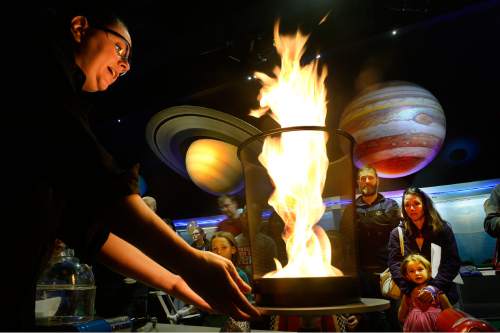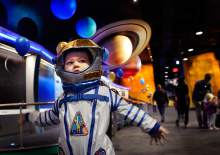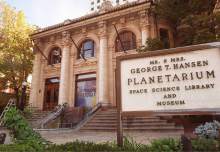This is an archived article that was published on sltrib.com in 2015, and information in the article may be outdated. It is provided only for personal research purposes and may not be reprinted.
It's less than the blink of an eye in cosmic time, but Salt Lake City now has enjoyed a planetarium for 50 years — one that is famous internationally, and is credited by some Utah scientists as the inspiration for their careers.
"Our star shows are in 35 different countries and in15 different languages," says Clark Planetarium Director Seth Jarvis. "You go to planetariums anywhere in the world, and chances are pretty good that one of our shows is on the schedule."
The planetarium was the first in the world to sell shows to others; the first to make star shows with plot and speaking characters; the first to turn science fiction stories into star shows (including original stories); and the first to use computer projection.
Jarvis adds, "It's remarkable for any city to have its own stand-alone planetarium. You really have to be a city the size of say, Chicago. Everywhere else, the planetarium is attached to a museum of natural history, or a science center, or something like that."
So, Jarvis says, "We've been described as punching above our weight."
The planetarium celebrated its golden anniversary on Saturday with a party that included 50-cent dome theater shows, special science demonstrations, refreshments — and people remembering its history in speeches.
It opened as Hansen Planetarium on Thanksgiving Day 1965 at its original building at 15 S. Main St., which had been the old city library.
As that library was closing, the Alta Club next door proposed to buy and demolish it to create a parking lot. But philanthropist Beatrice Hansen called the city library board and offered $400,000 to save the iconic building if it were converted it into a planetarium.
It would be called Hansen Planetarium until the original building closed in 2002, and was renamed Clark Planetarium (which has a Hansen Dome Theater along with an IMAX theater, always-free science exhibits and a store) when it opened in The Gateway in 2003.
The planetarium opened originally at the height of the space race to the moon between Russia and the United States.
"America was space crazy," says Jarvis. "One of the ways that manifest was there was a burst of planetarium construction around the country. So there are a lot of planetariums that have early to mid-1960s construction dates."
At the time, "Space exploration consisted of two guys in the Gemini spacecraft in low Earth orbit," Jarvis says. The planetarium then had a big space library, almost all of which is now obsolete because of then-undreamed-of advances that would come through such things as the Hubble Space Telescope.
In those early days, the planetarium featured a star projector — nicknamed "Jake" — that would rise from the floor with dramatic music, and special effects that were all homemade.
"Visuals were slides, and everything was controlled manually. You would have to rehearse to control this enormous console because you had hundreds of switches and dials, and you had to choreograph yourself to make sure you had your timing right to have special effects light up at the right time," Jarvis said.
Now, he said, "everything is generated by two computer projectors. And for star shows, you quite literally load the program and press play."
Jarvis has worked at the planetarium since 1978, and once ran that old console — as well as being an usher, cashier, educator, traveler with its Astrovan to schools, and director since 2001 (which he thought would just be a temporary assignment).
The planetarium was operated by Salt Lake City in early years, and by Salt Lake County since 1978. Jarvis says it has been forced to be creative to stretch tight funding.
That included the innovation of selling its shows to others. "At first, we would end up sending them boxes full of slides and a reel of audio tape and instructions on how to build some of the other effects."
Jarvis adds about his staff, "I don't think our community gets the talent, the passion, the expertise, the inventiveness, the pure creativity of these folks. They can stretch pennies until Lincoln screams. They are really good at pulling rabbits out of a hat with nothing but spit and hope."
"If you go to a planetarium anywhere in the world and ask them who does the most and the best, they would say Clark Planetarium," says Thomas Beckett, chairman of the planetarium board.
But he says he is perhaps most proud that "100,000 kids come in every year on field trips. And I love that fact that about 75,000 [more] kids see demonstrations in auditoriums and school rooms brought to them by Clark staff in Astrovans."
Jarvis says that inspired some Utahns to impressive scientific careers. He remembers how he was surprised to read a newspaper story about Lara Anderson, a Rhodes scholar from Utah.
"She is a fairly famous physicist now," and talked about how she had thought of being a novelist until she visited Hansen Planetarium as a 12-year-old.
"Her quote was: 'I never knew such mysteries existed to be solved' about the universe," Jarvis says, and she announced to her family on the spot that she would become a physicist.
Jarvis also shares an email he once received from M. Matthew Lensch, head of pediatric surgery at Harvard Medical School.
"When I was a young boy, without any doubt whatsoever, my favorite place in the entire world was the Hansen Planetarium," Lensch wrote. It was "where the wonders of the universe and how science works to explore them was first introduced to me" and led to his medical career.
"That's what we do here. We change lives for the better," Jarvis says. "People who know about the universe are more interesting. They are more fun to have as friends."
He adds that Clark Planetarium has some big future plans.
"Next summer we will be gutting the building and replacing all of the science exhibits. The new stuff is going to be jaw-dropping."
He adds, "There's not going to be artifacts behind glass boxes and then you read the description about them. It's going to be: 'Put your hands on this, and try to do that, and learn the physics lesson about it.' It's going to be amazing."
Twitter: @leehdavidson









